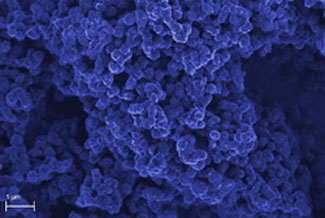| Nov 28, 2011 |
Fighting Parkinson's with carbon nanoparticles
|
|
(Nanowerk News) One of the problems affecting the human nervous system is dopamine deficiency. But testing of dopamine concentration is costly and requires sophisticated equipment not available in a doctor's office. Enter a team of Polish scientists who developed a method enabling the detection of dopamine in solutions both easily and cheaply, even in the presence of interferences. The study is an outcome of the NOBLESSE ('Nanotechnology, biomaterials and alternative energy source for the European Research Area (ERA))' project, which is backed with EUR 3.3 million under the 'Regions of Knowledge' Theme of the EU's Seventh Framework Programme (FP7). The results are published in the journal Biosensors and Bioelectronics ("Film electrode prepared from oppositely charged silicate submicroparticles and carbon nanoparticles for selective dopamine sensing").
|
 |
| Microscope image of an electrode surface with 24 layers of polysilicate submicroparticles coated with carbon nanoparticles. Such electrodes, developed at the Institute of Physical Chemistry of the Polish Academy of Sciences in Warsaw, Poland, allow for dopamine sensing in solutions in the presence of interfering substances. (© IPC PAS)
|
|
Scientists at the Institute of Physical Chemistry of the Polish Academy of Sciences (IPC PAS) in Warsaw coated new electrodes with carbon nanoparticles deposited on silicate submicroparticles to get the targeted result. They applied the electrodes so as to determine dopamine concentration in solutions in the presence of uric and ascorbic acids, and paracetamol, substances that get in the way of dopamine analysis.
|
|
This latest development to detect dopamine could clear the path for securing fast and inexpensive medical tests that doctors can use even in their offices. This information will help physicians determine the likelihood of a patient suffering from popular nervous system disorders including Parkinson's disease.
|
|
The researchers developed the electrodes by alternating layers of silicate submicroparticles and carbon nanoparticles. According to the team, the size of the silicate submicroparticles ranges from 100 nanometres to 300 nanometres (billionth parts of a metre). Being nonconductive, they are used only as a framework extending the electrode surface. Carbon nanoparticles, ranging between 8 nanometres and 18 nanometres in size, densely coat the silicate particles that form the actual conductive working surface.
|
|
'Carbon nanoparticles have negatively charged functional groups, and the silicates positively charged ones,' explains doctoral student Anna Celebanska of the IPC PAS. 'The electrostatic interactions between them are quite strong. We checked that by multiple repeating of the immersion, a "sandwich" consisting of up to 24 layers can be obtained on the electrode surface.'
|
|
The scientists applied the new electrodes for dopamine sensing in solutions. The carbon nanoparticle-coated electrodes are placed inside a prepared solution containing the same, and the electric potential is then applied. They say dopamine is electrochemically active and can be oxidised by adjusting the potential value.
|
|
'The results of the completed tests turned out very good,' Ms Celebanska says. 'Our method is among the most sensitive methods for dopamine sensing. It allows to detect dopamine at concentrations as low as 10-7 mole per litre in the presence of interferences at concentrations up to 10-3 mole per litre.'
|
|
Commenting on the results of the study, Professor Marcin Opallo says: 'The method has a natural detection threshold, and that's why we can conclude on dopamine deficiency in the body. How large is the actual deficiency? At present we cannot answer the question. We hope, however, for further increase in the method's sensitivity.
|

